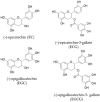Immunomodulatory Effects of Green Tea Catechins and Their Ring Fission Metabolites in a Tumor Microenvironment Perspective
- PMID: 39407505
- PMCID: PMC11478201
- DOI: 10.3390/molecules29194575
Immunomodulatory Effects of Green Tea Catechins and Their Ring Fission Metabolites in a Tumor Microenvironment Perspective
Abstract
Green tea is the second most consumed beverage following water, and the health benefits provided by its consumption have been well established from research in recent decades. The main bioactive compounds found in all Camellia sinensis-based teas are catechins, which have been reported to have antioxidant, anticancer, anti-inflammatory, and immunomodulatory properties. Although most of the health benefits are well established, studies show that the intact catechins as found in tea are poorly absorbed in the digestive tract. These compounds are degraded and undergo ring fission by the gut microbiota, increasing their absorption. In this review, we gather knowledge of the health benefits of green tea catechins and their metabolites, with a particular emphasis on the immunomodulatory effects in a cancer microenvironment scenario.
Keywords: catechin metabolites; green tea catechins; immune response; tumor microenvironment.
Conflict of interest statement
The authors declare no conflicts of interest.
Figures




References
-
- Gonçalves Bortolini D., Windson Isidoro Haminiuk C., Cristina Pedro A., De Andrade Arruda Fernandes I., Maria Maciel G. Processing, Chemical Signature and Food Industry Applications of Camellia sinensis Teas: An Overview. Food Chem. X. 2021;12:100160. doi: 10.1016/j.fochx.2021.100160. - DOI - PMC - PubMed
Publication types
MeSH terms
Substances
Grants and funding
LinkOut - more resources
Full Text Sources

